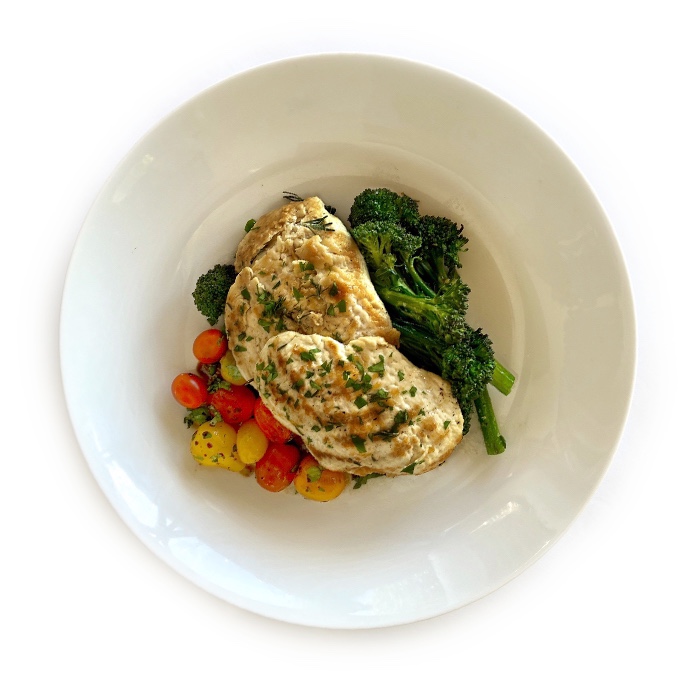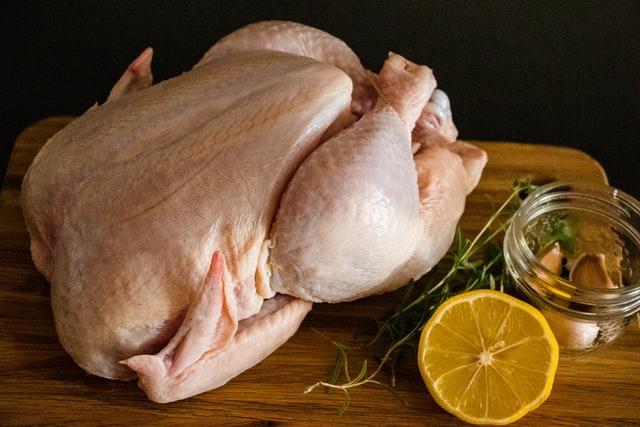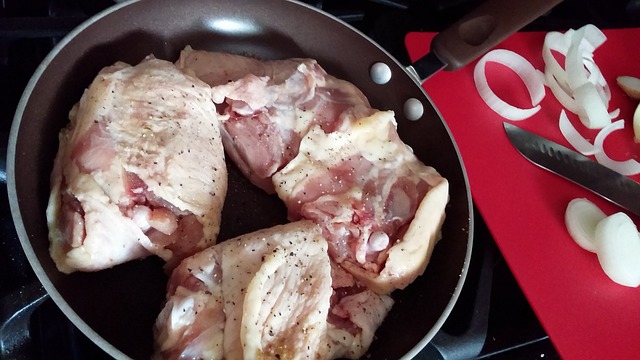Butchering whole chickens yourself at home is simple, cost-effective, and offers up a world of options. It will also aid you in the process of becoming a better cook.
Mychael Chang
There appear to be two ways of thinking about cooking at home, and each has implications for kitchen organization and practice.
The “Turkey” School vs. “Chicken” School
The first, which I call the “turkey” school of cooking because it is best typified by how most people prepare their Thanksgiving meal, sees home cooking as a sequence of discrete recipe-dictated acts, occasionally interrelated, all aimed toward the production of a specific meal. Meals can include one or more dishes, and each of those dishes, in this way of thinking, is a different activity, with its own process and set of components and instruments.
The second, which I’ll call the “chicken” school of cooking because I’m going to try to persuade you to buy whole chickens, takes a more holistic approach. Cooking isn’t just about producing a certain recipe or meal; it’s about manipulating components to create more comprehensive dishes and meals. The emphasis is on technique and cultivating an almost continuous work flow of food preparation that will allow for the manufacture of a wide range of dishes.
While articles about this method of cooking are published on a regular basis, such as one on how to more easily incorporate cooking dried beans into your routine, or advice on how to approach quarantine cooking, the turkey school dominates the pages of many food publications because it is the simplest way to organize and present information about preparing food.
How We Approach Cooking
Some magazines provide meal planning instructions that recommend going to the grocery store once a week or once a month for a range of more efficient meals, but even this might be unduly restrictive. Many home cooks, particularly inexperienced ones, are unaware of how better the chicken school may be, both in terms of cost-effectiveness and adaptability. If you are not used to thinking about food without first consulting a recipe, you may believe that depending on recipes and their very rigid ingredient lists is the ideal approach to cook all of your meals.
However, there are substantial drawbacks to that strategy, and there are numerous advantages to taking a more comprehensive approach. And now, since we are all driven to cook more frequently at home and restrict the amount of trips to the grocery store due to the coronavirus pandemic, I feel everyone’s time in the kitchen would benefit from adopting, or at least inching toward, the chicken approach.
And an ideal way to get started is to commit to just buying entire chickens.
Purchase Chickens Whole and Cut Them Up Yourself
Whole chickens cost less per pound than plastic trays of bundled chicken parts and are just about on par with chicken backs and offal. It’s doubly cost-effective if you use the whole bird efficiently, and if you don’t follow any diet that forbids eating chicken or some of its components. The meat you prepare and consume is less expensive than it would be for processed parts and the carcass may be made into chicken stock.*
*In a similar spirit, you can utilize vegetable scraps to enhance the stock you create with the carcass, as I do.
While food costs are always important to consider, the biggest advantage of buying whole chickens and chopping them up is not the cost reduction. It’s that practice will make you a better cook, more proficient at finding out how to make tasty meals with what you have on hand.
Cooking a chicken whole, regardless of manner, yields only one dish and some stock. However, by obtaining entire birds and cutting them into their component parts prior to cooking, you double the possibilities of what you can prepare; moreover, you’ll be pushed to produce multiple distinct dishes because those component parts all taste best when cooked in different ways.
For example, the carcass is excellent for stock, the breast for cutlets, the legs for braising and roasting, and the wings for curing overnight on a rack with salt and roasted till crisp in a hot oven. However, the possibilities, which I’ll discuss further below, are limitless.
To do this effectively, you must first learn how to break down a chicken.
Whole Chickens: An Opportunity to Level Up Your Skills
Another advantage of making it a habit to buy whole chickens and chop them up is the ability you develop in handling and butchering meat as a result of regular practice.
Butchering animals is an important cooking skill (assuming you eat meat, of course), but because of the way our food systems are now set up, many home cooks either intentionally or unconsciously outsource it to meatpackers and butchers.
Buying chickens is the simplest and cheapest way to practice taking apart animals, while other animals, such as lambs, pigs, and cows, are a little too large for home cooks to handle easily. The thing to understand about most of the terrestrial animals we eat is that they’re all built similarly, so deep familiarity with the best methods for jointing a chicken, for example, is easily translatable to the physical structure of a goose or turkey, and knowing your way around muscle groups in a chicken leg will come in handy when and if you ever need or want to cut up a leg of lamb.
Practice Makes Perfect
On a more basic level, if you consistently chop up a full chicken, you will inevitably become quite skilled at it. The ability to separate a chicken into breasts, legs, wings, and a carcass in under 10 minutes will soon be yours. (And, due to the relatively high risk of foodborne illness associated with handling raw chicken, you will, by necessity, get better at adopting proper meat-handling techniques, such as often washing your hands and avoiding cross-contamination of surfaces.)

Familiarity is the first step toward becoming proficient in any skill, and overcoming any obstacle that makes cooking a chore, such as recoiling at the thought of breaking down a whole chicken, will give you more opportunity, time, and leisure to focus on how to turn that chicken into something delectable.
To Be Continued…
This takes us to the end of part one. Does it feel like a cliffhanger, or do you think this post could stand alone? Let me know in the comments below and also weigh in on whether or not you like these series style posts that we have been creating, I’m curious to hear your thoughts. Don’t forget to check out part two, you can go straight there by clicking here. Always remember that when it comes to the kitchen (and most things in life), MAXIMUM QUALITY, MINIMUM EFFORT!! I’ll see you soon…

